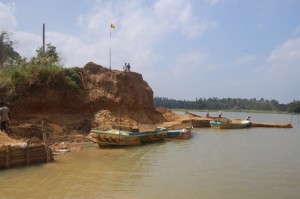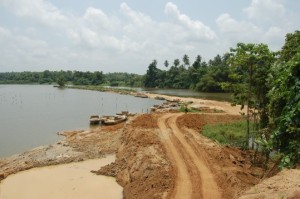

by Dharshani Weerasekera
Sand mining in Sri Lanka is not only undercutting riverbanks, it is also undermining water quality, ecosystems and land use, and, according to some, the country’s recent economic progress.
In Sri Lanka, artisanal or manual sand mining from rivers has supplied the country’s construction industry for hundreds of years. Since 1990, the introduction of mechanized methods has led to intensive river sand mining (RSM). The 2004 tsunami and the end of the civil war in 2009 precipitated a construction boom, which doubled the pre-tsunami annual demand for sand from 5 to 10 million cubic meters1. Despite Supreme Court intervention in 2004, which allowed artisanal mining only at specific locations, illegal mining continues. So, what effect is RSM having on the environment and on dependent local communities?
Reduced land viability and biodiversity
Of Sri Lanka’s many rivers, 35 flowing close to either towns or construction sites have been seriously affected1 by RSM. Some of the obvious impacts include erosion and collapse of riverbeds and riverbanks, and widening of rivers and possible changes in their course. Deforestation, desertification and habitat destruction are other dire results. The consequences for communities in affected areas are serious, as land traditionally used for agriculture, animal husbandry and home gardens is reduced or disappears. In major rivers that support agriculture and water supply, unsustainable RSM has lowered riverbeds, causing saline intrusion.
The extent and nature of the impacts vary. In places, riverbeds have been lowered below sea level, triggering seawater intrusion and the salination of natural water bodies and soils, with harmful short- and long-term effects. For example, over 5,000 hectares of traditional paddy lands in Kiralakele, Matara District, were abandoned because of saline intrusion along the Nilwala Ganga2 – the only source of piped drinking water for the district. Extensive mining has forced water intake points for the region’s municipal water supply further upstream due to creeping seawater contamination2. Indiscriminate and uncontrolled sand and clay mining along the Maha Oya in the west threatens to lower the riverbed and the water table3.
Although most sand is mined from riverbeds and riverbanks, coastlines and river deltas have not escaped and suffer erosion and saltwater intrusion. Their ecosystems have become more vulnerable to tidal flooding. The most severe coastal degradation can be seen near the mouth of the Maha Oya3. Here, many abandoned and currently mined pits are found side-by-side, and have widened the river. The resulting riverbank erosion has led to the loss of productive land and livelihoods, and affected ecosystems and biodiversity.
Erosion of social fabric adds to economic costs
Lowered water tables and increased salinity have ruined more than agriculture. Household Incomes of the poorest families have been affected; damaged coconut plantations and paddy lands have increased the migration of labor to towns, putting pressure on infrastructure and eroding the social fabric of villages.
“The economic costs of RSM have only recently being flagged,” says Kusum Athukorala, Chair of the Sri Lanka Water Partnership, a non-profit organization promoting integrated water resources management. “The stability of roads and bridges near rivers as well as natural protective coastal sandbanks are being compromised. An economic analysis of sand mining is urgently needed. No one has quantified the cumulative impacts to see their real cost to the country.” An Environmental Foundation policy report3 recommends assessment and comprehensive joint monitoring mechanisms. A licensing system by the state Geological Survey and Mines Bureau restricting artisanal mining to identified locations has had limited success. Monitoring all mining activity along every river has been problematic due to selective and fragmented enforcement, insufficient manpower and other pressures.
For the ecosystems and their dependent communities, and habitats affected by RSM as well as the wider society, holistic and sustainable solutions seem to offer the best hope. In the Matara District, participatory programs involving local communities, and networking between community-based organizations have helped reduce RSM and its impacts. Integrated, multi-agency collaboration with community buy-in have reduced the practice in the area since 20002, and systems to establish Payments for Ecosystem Services (PES) may help. Research for viable alternatives to sand for construction purposes is also imperative. Sri Lanka’s enviable natural resources underpin its economic development and can do so for many more years, but only at the right price.
References
1Ratnayake, R. Unregulated/illicit river sand mining in Sri Lanka – Impact of awareness campaign and legal recourse. Colombo, Sri Lanka: Sri Lanka Water Partnership.
2Piyadasa, R.U.K.; Navarathna, C.M. River sand mining in Southern Sri Lanka and its effect on environment. University of Colombo and University of Ruhuna.
3Karunaratne, W. Impacts of sand and clay mining on the riverine and coastal ecosystems of the Maha Oya: Legal and policy issues and recommendations. Environmental Foundation.
Dharshani Weerasekera is an independent development science writer. This article was funded by IWMI, but the views expressed are the author’s own.

